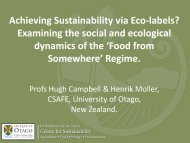Book of Abstract (incl. addendum) - IFSA symposium 2012
Book of Abstract (incl. addendum) - IFSA symposium 2012
Book of Abstract (incl. addendum) - IFSA symposium 2012
You also want an ePaper? Increase the reach of your titles
YUMPU automatically turns print PDFs into web optimized ePapers that Google loves.
Workshop 6.4 Integrated simulation modelling in farming systems research<br />
The paper builds on recent research (TOP-MARD) which explored the complex interrelationships<br />
between policies, the multiple (public and private) functions <strong>of</strong> agriculture and farm<br />
households (‘multifunctionality’), and the development <strong>of</strong> rural regions and the quality <strong>of</strong> life <strong>of</strong> people<br />
living there. System dynamics was appropriate in this case because <strong>of</strong> our interest in the interaction and<br />
feed back effects among economic, social and environmental systems. A model was developed in<br />
common between 11 European research partners and then adapted to the individual regions within the<br />
area <strong>of</strong> multifunctionality and sustainable rural development to analyse the impacts <strong>of</strong> different public<br />
policies. In this paper the model is applied to the Norwegian study area, Hordaland County. The study<br />
finds that reducing agricultural subsidies can lead to improvements in regional economic performance<br />
by releasing labour and capital to uses with higher returns and by creating positive feedback to the<br />
economy by improving environmental quality and overall quality <strong>of</strong> life.<br />
Finally we will broaden these results for a general discussion on the importance <strong>of</strong> a holistic<br />
approach to the analysis <strong>of</strong> policy and indeed market impacts over time if progress is to be made<br />
towards more sustainable rural futures.<br />
Dynamilk: a farming system model to explore a better match between<br />
forage and milk production<br />
Anne-Lise Jacquot, René Baumont, Luc Delaby, Dominique Pommiès and Giles Brunschwig<br />
VetAgro Sup/INRA, France<br />
Anne-Lise.Jacquot@vetagro-sup.fr<br />
Dairy systems based on grasslands are sensitive towards environmental variations (climatic events) and<br />
production constraints changes. A better match between dynamic <strong>of</strong> dairy cattle needs and herbage<br />
supply could allow the farming system to lean towards a better forage self-sufficiency at farm-scale<br />
and to be more resilient to changes.<br />
Modeling approach enables to study several scenarios with contrasted strategies <strong>of</strong> biotechnical<br />
subsystems management in order to test different calving distributions, cattle and grasslands<br />
characteristics, or practices on pastures and meadows. A dynamic model at the farm-scale can also<br />
show the impacts <strong>of</strong> changes on the whole production systems over many years. In particular, such a<br />
dynamic model, called Dynamilk, has been created and implemented. Dynamilk is focused on<br />
relationships among dairy cattle, management and resources. This model is based on a bio-technical<br />
approach focused on grassland use by animals. Grassland sub model which consists in biodiversity<br />
characteristics and grass growth components has been developed by Jouven (2006). This paper is<br />
focused on this dairy cattle sub model’s development.<br />
Dairy cattle sub model consists in 2 units: demographic structure unit and intake, milk<br />
production and body reserve use unit. This model considers calving period and distribution, dairy cattle<br />
characteristics (ability <strong>of</strong> animals to produce milk and use its body reserve) in order to test the match<br />
between animal needs and feed supply. Milk production according to herbage and feed supply is the<br />
main output <strong>of</strong> Dynamilk. This sub model <strong>incl</strong>udes 3 major batches: milking cows, dry cows and<br />
replacement heifers. Validation <strong>of</strong> dairy cattle sub model has been carried out. Model behavior and<br />
sensitivity on major input parameters are assessed to be relevant according to modeling objectives. Its<br />
prediction has been compared against experimental data, Root Mean Square Deviation: 1.8 and 2.1 for<br />
indoor trials; 1.4 kg <strong>of</strong> milk for grazing trial.<br />
127











